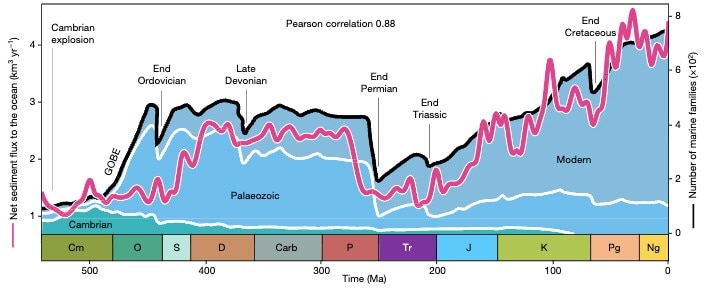Sediment fluxes to the oceans (pink) vs diversity of marine animals (black) over the past 540 million years. The correlation is striking. (Extinction events are marked) Source: Nature
Using open-source scientific code published by the team in Science in March, the detailed simulation was calibrated using modern information about landscape elevations, erosion rates, major river waters and the geological transport of sediment (known as sediment flux).
This allowed the team to evaluate their predictions over 500 million years using a combination of geochemical proxies and testing different tectonic and climatic reconstructions. The geoscientists then compared the predicted sediment pulses to the evolution of life in both the marine and terrestrial realms obtained from a compilation of paleontological data.
“In a nutshell, we reconstructed Earth landforms over the Phanerozoic era, which started 540 million years ago, and looked at the correlations between the evolving river networks, sediment transfers and known distribution of marine and plant families,” University of Grenoble PhD student Manon Lorcery said.
When comparing predicted sediment flux into the oceans with marine biodiversity, the analysis shows a strong, positive correlation.
On land, the authors designed a model integrating sediment cover and landscape variability to describe the capacity of the landscape to host diverse species. Here again, they found a striking correlation between their proxy and plant diversification for the past 450 million years.
In his 1864 novel A Journey to the Centre of the Earth, Jules Verne attributes this to his fictitious hero, Professor Otto Lidenbrock:
“Animal life existed upon the Earth only in the secondary period, when a sediment of soil had been deposited by the rivers and taken the place of the incandescent rocks of the primitive period.”
Dr Salles said: “This observation by Professor Lidenbrock to his nephew Axel fits strikingly well with our hypothesis. So, it should be no surprise that Jules Verne was greatly inspired by Humboldt’s work.”
Research
T. Salles, L. Husson, M. Lorcery, B. H. Boggiani
‘Landscape dynamics and the Phanerozoic diversification of the biosphere’ (Nature, 2023)
DOI: 10.1038/s41586-023-06777-z
Declaration
This research was undertaken with resources from the National Computational Infrastructure supported by the Australian Government and from Artemis HPC supported by the University of Sydney. This work was supported by the Australian Research Council (IC190100031).
